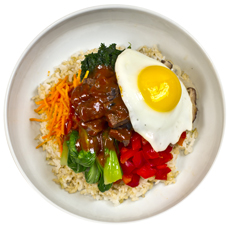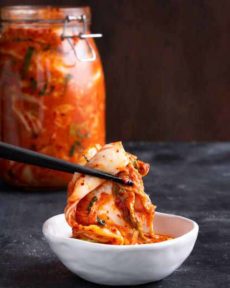KOREAN FARE: Easy Homemade Bibimbap Recipe
|
One of our favorite Korean dishes is bibimbap (pronounced BEE-bim-bop), a comfort food recipe that’s easily customizable to your tastes. It combines rice, protein, fresh vegetables and spicy Korean barbeque sauce. The dish is traditionally made, mixed and served in a Korean stone bowl (also called hotstone or dolsot). You can use a regular skillet and a dinner plate. With a stone bowl, the rice on the bottom becomes extra crisp and crusty and is considered a bonus, like the socarrat on the bottom of paella pans. Already low in calories and healthful, if you substitute a [nontraditional] whole grain for the white rice, it becomes a very nutritious dish. Consider black, brown or red rice, or barley (bap is the Korean word for cooked rice). Quinoa fans: Go for it! Below are five easy steps to making bibimbap at home from Bibigo, maker of Korean pantry products. Ingredients 1. COOK the rice and vegetables. Slice the raw vegetables. 2. MAKE the marinade: Combine soy sauce, sugar, garlic, ginger, sesame oil and pepper in a mixing bowl. 3. COMBINE the marinade and protein in a skillet over medium-high heat, and stir frequently until just cooked through. If you are using cooked vegetables (bean sprouts, mushrooms, onions, spinach, e.g.) you can cook them in this skillet. 4. PLACE the rice in bowls or on plates, and top the rice with the cooked protein and cooked vegetables, reserving the cooking juices. Arrange raw and cooked vegetables atop the rice. Mix the pan juices with the gochujang sauce. 5. FRY the eggs sunny-side up and place one on top of each bowl. Right before eating, toss in the gochuchang sauce. Garnish to taste and serve with gochujang sauce. |
|
|
|
Chuseok is a big family holiday in South Korea, similar to Thanksgiving in the United States. It’s celebrated for three days in September or October, based on the Lunar Calendar. Most people travel back home for the holiday to the head of the family (usually the grandparents’ home). There is always a large gathering of family, delicious foods to eat, and often a gift for the hosting family. The gathered family may also hold a ritual during Chuseok to pay respects to their ancestors. This is usually done with a memorial table holding an offering of food and drinks. You can certainly make bibimbap for the occason. Traditional popular foods include: Gochujang (pronounced ko-chu-JONG, also translated as kochujang) is a Korean hot chile pepper paste, spicy, but not too hot. It is made from glutinous (sticky) rice, red chiles, fermented soy beans and salt. Gochujang is one of the three indispensable condiments in Korean households, along with doenjang, bean paste, and ganjang, Korean soy sauce. The popular condiment is used in bibimbap as well as in bulgogi (barbecued meat wrapped in lettuce leaves), tteokbokki (a snack food made from soft rice cake and fish cake), and in salads, stews, soups and marinated meat dishes. You can also spread it on burgers and sandwiches for some fusion flare, use it as a breakfast condiment with eggs or hash browns, or mix it with soy sauce, rice wine and a bit of brown sugar to make a delicious dipping sauce. > Here’s a different recipe for bibimbap (photo #4). > Bibimbap with SPAM instead of beef. *Bulgogi is thinly sliced, marinated and grilled beef. The word literally means “fire meat” in Korean. CHECK OUT WHAT’S HAPPENING ON OUR HOME PAGE, THENIBBLE.COM. |
||






